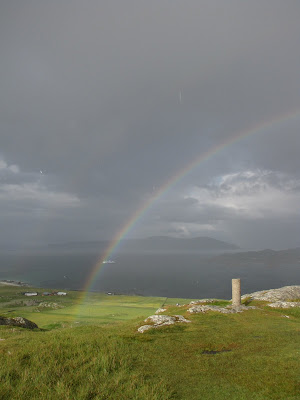
Columba landed in Iona in 563. He had recently left Ireland after a dispute over a psalter had got out of hand and led to a pitched battle in which many men were killed. Filled with guilt and remorse, he was determined to work for the Lord by converting the pagan Picts and Gaels who inhabited the west coast of Scotland. So he arrived, on the stony beach of what is now Columba Bay and set to work to build a monastery as a base for his evangelical operations. The Island is small and the soil thin. It only rises a few hundred feet above sea level but it is riven with cliffs and crags and rocky outcrops. In winter the wind reaches 70 mph and there is rain all the year round. He prayed, built his community, prayed, collected a library of holy books and prayed. He became known as a holy man and many miracles were attributed to him; consequently, he was trusted by the Pictish chieftains and became arbiter and diplomat between them. His evangelical efforts were wildly successful.
When I followed his trail 1400 years later, all traces of his occupation were gone. There is a cross dating from the 9th century and the shells of some buildings from medieval times. There is a cluster of small houses, some a few hundred years old but all of them extensively rennovated and developed in the 19th and 20th centuries. The modern Iona Community has sensitively restored the medieval abbey buildings, and added to them.
We arrived, like everyone else, on a ferry boat and stayed about a 2km walk from the ferry. Our host was a lovely young woman from Mosgiel who was partner to one of the local farmers, and who had recently restored their farmhouse and now let it out as a B&B. It was warm, quaint and very well appointed. On our first day we saw all the old buildings -quite an easy task - and then walked across the island from one side to the other. The next day we walked from one end of the island to the other, ending in Columba Bay where we sat on the stony beach in company with tough, horned highland ewes and their lambs. It was a wild place to arrive at, and it seemed a strange place to begin a mission.
I thought of the way our own church does things: getting motions passed in synod, gathering money, finding personnel and getting them trained and certified, making sure everything is done according to the canons and to the five fold mission statement. If we were going to convert the Picts I doubt that we would dump a few blokes on a stony beach on a bit of Island that no-one really wanted and leave them there to get on with it. We would at least need to see the budget projections first. But really, Columba's way was the only way to build something lasting. He landed and encountered this beautiful but desolate place and could only proceed by coming to terms with the ferocity of his environment and by utter dependence on God. His mission was grounded in the real world of the Picts, and on the holiness which comes from repeated, daily, disciplined prayer. To sit on the stones at the north end of Iona was to be brought face to face with the bedrock of the faith. Strip away all the accretions: all the synods and buildings and books of canon law and this is what you start with: the surf rolling over the rounded marble pebbles and the wind howling up the bay. That is, we start with God and the earth which is the outworking of his continual creative presence.
I have wandered, blindly most of the time, and ended here: about as far from home as I can get; but I have also made another journey, to the centre of what I have faith (ie trust) in. At the centre of faith it is equally rocky and sparse and desolate; but it is also equally rich in promise and the hope of new life.
Comments
Well, what I mean is, that all those years after Columba's mission, here you set out from the South of the world and up there in Iona you make the connection you've just written about.
Dunedin and kilometres of Aotearoa are fringed with wild beaches on which you have probably sat alone, surrounded by God's power in the pounding surf or the stillness of a bay. At least that's where I have often been fortunate enough to go seek to be assured that GOD IS THERE in that raging power or in the quiet.
So is there something in the knowing that in 563 God's worker was on Iona that makes a difference?
Do you think the Presbyterians who made it here in 1848 to a wild and desolate land felt like Columba and tried to make a difference?. At least their churches are in stone and they laid lasting foundations in education.
If gold had not been found if Otago ...
(pointless musing, I know)
I just think God is amazing in the way each of us is so provided for all along the way. And we don't need all the "stuff" that the church has accumulated.
AND then again, you have recently been led to some wonderful discoveries in some of those very buildings ...
I am confused!
That's why they called their school Columba College. Some of them even called their daughters names like 'Iona'.
Nec tamen consumebatur.
I won't ever forget visiting the place many years (in kinder weather) and meeting a young couple in a B&B who 'outed' me at breakfast: 'Why have you come here? Is it because you're a Christian?'
Brian
Prayer and worship.
That's a life's work!
N